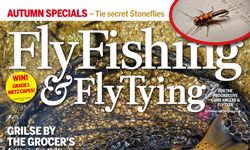Could I put together a magazine to celebrate 100 years of the PPA? Oh, OK then, why not. It might just be fun.
And – overlooking my abysmal underestimation of quite how much work this would entail – it was. No, really.
I got to speak to a couple of hundred people from all over the business, and at all levels. They were mostly impressively honest and insightful and keen to nail their thoughts about where the industry’s heading.
But the pages I enjoyed compiling the most belonged to a big section called “100 Great Magazine Moments”. Not “The Greatest 100”, note – I value my life – but simply examples of some of the many brilliant things magazines have done over the years.
They were much harder to research than I thought. Google did not conveniently lob them into my laptop for me to cherry pick from, as I’d blithely assumed. It turns out that we have not, as an industry, been very good at archiving our content. But then we’ve had other things on our minds, have we not? After all, giants like Google, Facebook and Twitter, or devices like tablets and smart phones, didn’t even exist a few years ago, and now don’t merely dominate the media landscape but every other landscape too. We’re pitched headlong into a mad scramble to second-guess where it’s all leading. Why would anyone want to spend valuable time wallowing in nostalgia?
Here’s why.
If compiling those Great Moments was a labour of Herculean proportions, then by the end of it, my long-running love affair with magazines had turned full circle, straight out of the “Your turn to take the rubbish out, dear” stage and right back to the intoxicating moment of “Wham, bam, I’ve fallen – and hard”.
Great moments
There was Spielberg guest-editing Empire in 2009; the NME creating the UK’s first official record chart in 1952; Haymarket’s staggering achievement in producing a daily Olympics special; Country Living’s bold move into brand extensions with the sell-out success of the first Country Living fair in 1992; Building magazine’s 1998 headline-grabbing story of the shocking 40 per cent over-budget cost of Westminster’s new Portcullis House; Computer Weekly’s sustained campaign leading to an unprecedented independent inquiry into the out-of-control costs of the NHS IT programme; Peter York’s sect-spotting genius of the Sloane Rangers for Harpers & Queen in 1975; Thatcher’s landmark “There is no such thing as society” interview with Woman’s Own in 1987; Gail Porter’s naked butt on the side of the Palace of Westminster promoting FHM in 1999… It could easily have been 1,000 moments – or 10,000.
Bold, important, audacious, funny, witty, angry, controversial… all these moments were – and still are – fantastic. They made me want to jump up and down with excitement. (Actually, a couple of times I really did.) They are a tribute to the bubbling broth of inspired ideas, focus, vision, instinct, market knowledge and absolute determination without which none of them would have seen the light of day. These are the moments that define magazine brands; the memorable magic in the mix. It's the difference between producing a magazine and a washing machine. The washing machine might have all kinds of extraordinary functionality but you're never going to have feelings for it. Well, maybe you will. I just hope I don’t know you.
Extinguishing the flame
But if that kind of spark is what defines a great magazine brand, then we’re running the risk of it being extinguished. The story you won’t hear – and certainly not on the record, anyway – is how absolutely, totally, completely knackered teams are. In the past few weeks alone, I’ve talked to half a dozen editors who I genuinely think are on the verge of collapse. The story doesn’t vary: “There’s just no time to do anything properly. We're having to provide so much more with so much less resource." Yet in public they talk about how exciting it all is. Very, very exciting. Oh yes. How can they not?
That's not to say that plenty of people aren't enjoying the excitement and dynamism of living in a platform-agnostic world. Don’t look to me to get misty eyed over the John Bull printing-press era. When I was starting out, I’d have killed to have the kind of instant access to reader feedback and communities that are now just-about commonplace.
But the overwhelming demand to provide content, content, content around the clock in many cases (and no, not all – please spare me the howls of complaint) is leading to a culture of repurposed job-lot editorial. The focus is increasingly on generating links and traffic rather than content of real worth and insight, with many editorial teams feeling they have been sidelined in the scramble to be digital-first.
I know some hugely talented and relatively experienced editorial people who simply dare not say to their CEOs that they think at least some of their digitally driven strategies are bollocks. They’re scared of being labelled as dinosaurs – and relatively expensive ones at that – compared with the cheaper labour supply coming in from journalism colleges. Yet these are people who climbed the ladder because of their vision, their ideas and their ability to make things happen. Surely these are talents we should be celebrating, not silencing?
I was struck by the comments from a small, young team I worked with for a couple of days producing a piece of print to support their digital work. Most hadn’t touched print for at least a couple of years, if at all, and found it surprisingly stressful. The consensus was that print was much more demanding and much less forgiving. I quote: “We shove all sorts of crap up on the site usually, and just keep our fingers crossed. Besides, we can always change it later. The thing about print is that it’s got to be much higher quality; it’s got to be right – but where are we supposed to find the time for that?”
Hmmm.
Where are the mavericks?
I was also struck by the fact that all of them had arrived fully formed out of journalism college, able to do more things across more platforms than I ever can or will. Good for them. They can knock off some copy, bash out a page, scribble a blog, record a vlog, put it about on social media and make a pretty reasonable fist of it. But you know what? When I look through those 100 Great Magazine Moments, they were not job-lot journalism. They were not banged-out bits of copy or “that’ll do” design. They were bloody brilliant. Top designers, top writers, mavericks, obsessives, wanting to excel and constantly looking for new ways to expand and hone their specialist skills. Are we going to build a whole new era of exciting magazine brands on “pretty reasonable”?
Everyone I spoke to for PPA 100 agreed that the future is platform neutral with multiple revenue streams. Everyone agreed about building new kinds of loyalty, connecting to people rather than simply holding forth at them. And everyone, but everyone, told me how crucial it is to have a strong brand.
Yet here we are in 2014, with not only every other type of media company’s tanks parked on our publishing lawn, but just about every other kind of company too, and all starting to do TV and radio and blogs and vlogs and apps and social media and produce loads of content and generate revenue through click-through purchase and affiliate partnerships. Hang on a minute. Where exactly do magazine brands stand in all this? Is our future really just going to be about posting inoffensive bits of repurposed copy against a click-through business model to chase traffic? This is the magic of magazines?
How often in my PPA research did I hear how collaborative and commercial editors are becoming? How very obliging we’ve been. How very dismal.
I believe in mavericks. Not nice little cooperative teams showing their taskmasters how flexible and hard working they can be. I want some bloody-minded maniac to say “Let’s try this”…
That’s what leads to memorable, standout moments – and standout moments are what you need if you want to achieve cut through (something else that a great many interviewees fretted about – and especially, nota bene, the younger ones).
Loads of CEOs talked of the world-beating creativity of British magazines. But you won’t get too much of that when ever-smaller teams are feeling crushed by the 24/7 demands of the great Content Monster.
I immediately retweeted a recent post from Bob Sacks – a US publishing veteran – saying: “I’ve seen too many publishers save $$ wrongly instead of investing in editors with the power of creating intriguing, addictive, thoughtful words.” No matter how understandable the need to control costs ruthlessly, until that great day when we can have real confidence about sustainable revenue streams, the fact is that salami slicing does not produce an appetising and inspired smorgasbord.
Neither does being super-busy. In a recent RSA video, Dave Coplin, Chief Envisioning Officer (I’m loving all these new job titles, aren’t you?) at Microsoft UK argued that technology can end up imprisoning rather than empowering. That people are too busy being busy to think creatively.
And the same goes for jacks-of-all-trades. I punched the air when I read the comments of David Carson, a Californian designer, in the new Jashanmal Quarterly (thanks for that one, Stack Magazines) when he said, “A computer or piece of software won’t make you creative or give you an original idea or way of working. What you have now is a lot of B magazines – all solid, safe, predictable, grid-reliant and forgettable. Largely because everyone has the same software, and designers let the computer make too many decisions. Everyone’s a designer, everyone’s a photographer and everyone’s a writer.”
I am not alone.
I practically kissed the feet of Condé Nast's Nicholas Coleridge (lucky escape there, Nick) when he told me how hugely important it was to make sure that editors should be fully part of the transition to digital without themselves being turned into techies: “In the end it’s about ideas.”
And Adrian Barrick, Chief Content Officer of UBM, was one of the few to volunteer that, although big data is all very well, behavioural analytics can’t be allowed to run the show. It’s time for editors to get their mojos back. “For all the analytics tools now, we mustn’t deny the ability to say, “Why don’t we just do…””
More to the point, what if we don’t?
You can see a copy of PPA 100 — The First 100 Years at www.ppa.co.uk/ppa100
Picture credits: Cosmo’s Playboy (Hearst Magazines UK), Spielberg edits Empire (Robert Gallagher / Empire), Jessica Ennis cover (Haymarket Network), Woman’s Own Thatcher interview (IPC Media), Ribbon wrap for Prince William’s wedding (The Lady).












